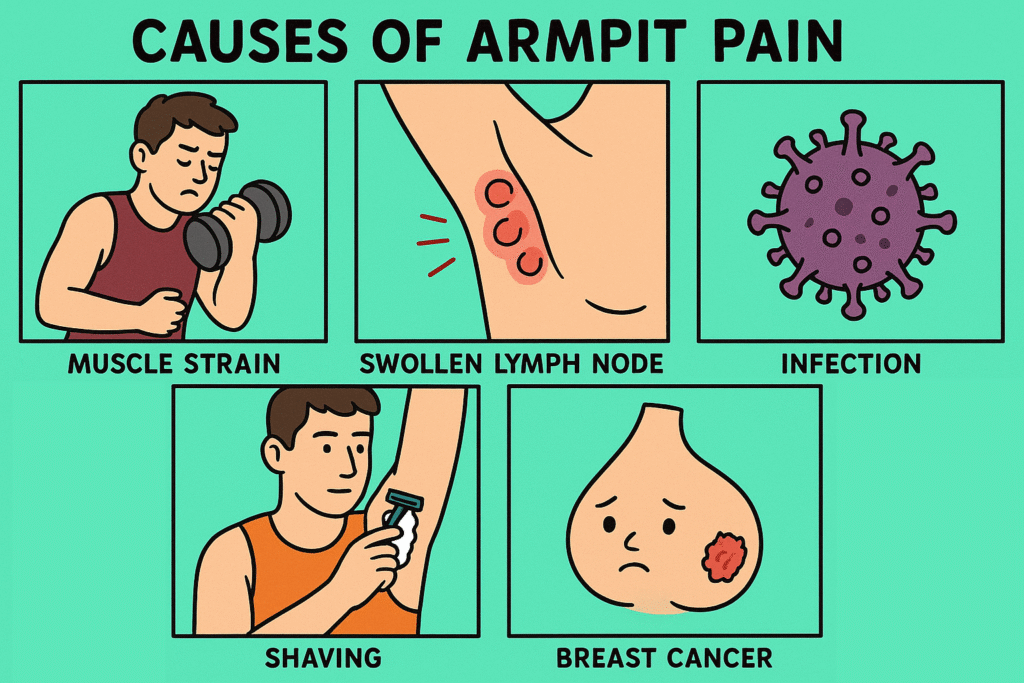Armpit pain might not be something we talk about often, but when it strikes, it can really catch you off guard. It’s a tender area packed with nerves, glands, muscles, and blood vessels—so even minor issues can feel quite intense. Whether it’s a dull ache, a sharp jab, or a lingering soreness, understanding what’s behind that pain can help ease your worries and get the right treatment.
What is Armpit Pain?
Armpit pain, also known medically as axillary pain, refers to discomfort or aching in the area under the arm, where the arm meets the shoulder. It can occur on one or both sides and may be mild or severe, constant or occasional.
While sometimes it’s as simple as a strained muscle, armpit pain can also point to issues with nearby structures—like lymph nodes, nerves, or even referred pain from the chest or shoulder. It’s not always serious, but persistent or severe pain deserves attention.
How Does Armpit Pain Happen?
Let’s break it down.
Think of the armpit as a crossroads. It’s where muscles, nerves, lymph nodes, sweat glands, and connective tissues meet and work closely together. If any one of these is inflamed, infected, compressed, or injured, it can cause pain.
Here are a few examples:
- Pulled muscle? You might’ve strained the pectoral or shoulder muscle from lifting or exercise.
- Swollen lymph nodes? Your immune system could be fighting an infection.
- Nerve compression? You may feel sharp, shooting pain if a nerve like the brachial plexus is irritated.
In short, pain here isn’t always coming from the armpit itself—it might be the messenger for something deeper.
What Causes Armpit Pain?
About 70 words in: Armpit pain can be caused by a variety of reasons—some as minor as shaving irritation, and others more serious like infections or nerve conditions. Knowing the underlying cause is key to finding relief.
Here are some of the main causes:
- Muscle strain (most common) – Happens after lifting, sports, or awkward arm movements.
- Swollen lymph nodes (20–30%) – Usually due to infections, flu, or sometimes even cancer.
- Infections – Like abscesses, hidradenitis suppurativa, or fungal infections.
- Shaving or allergic reactions – Can cause irritation or folliculitis.
- Nerve issues (e.g. brachial neuritis) – Inflammation of nerves supplying the shoulder and arm.
- Breast-related conditions – Such as mastitis or, in rare cases, breast cancer spreading to nearby lymph nodes.

Who’s at Risk?
Here’s a quick overview. Armpit pain doesn’t discriminate, but some people are more likely to experience it.
Top Risk Factors:
- Active individuals or athletes – Higher risk of muscle strain or shoulder injuries.
- People with recent infections – May develop swollen lymph nodes.
- Shavers or those using deodorants with alcohol/fragrance – More likely to get skin irritation.
- Women breastfeeding or postpartum – Risk of mastitis or clogged ducts.
- Individuals with diabetes or obesity – More prone to skin infections like boils or hidradenitis.
Other Symptoms That May Come With Armpit Pain
Sometimes armpit pain comes alone. But often, it’s part of a bigger picture.
Common companions include:
- Swelling or lumps
- Redness or warmth (suggests inflammation)
- Itchiness or rash
- Fever (may point to infection)
- Pain that worsens with arm movement
Worsening symptoms may signal a more serious cause:
- Lumps that don’t go away
- Numbness or tingling down the arm
- Night sweats or unexplained weight loss
- Pain spreading to chest or breast area
If any of these show up, it’s time to see a doctor.
Tests to Identify the Cause
So, how do doctors figure it out?
The gold standard starts with a physical exam, followed by imaging or lab tests depending on the findings.
Common diagnostic tools:
- Ultrasound or mammogram – To check for cysts, abscesses, or breast conditions.
- Blood tests – To detect infection or inflammation.
- MRI or CT scan – If a nerve issue or tumour is suspected.
- Lymph node biopsy – If a suspicious lump is found and cancer is a concern.
Doctors often start simple and only order more tests if the pain is persistent or paired with concerning symptoms.
Treatment for Armpit Pain
Good news—most cases of armpit pain are treatable at home or with basic medical care.
Mainstream treatments:
- Rest and avoid aggravating activities
- Pain relievers like ibuprofen or paracetamol
- Warm compress to soothe muscle pain or encourage drainage
- Antibiotics if an infection is present
- Topical creams for skin irritation or fungal infections
Other options if symptoms don’t improve:
- Physical therapy – Especially for nerve or muscle-related issues.
- Drainage of abscesses – A minor procedure done at a clinic.
- Surgery or further treatment – Only if cancer or serious disease is found.
As always, the treatment depends on the cause. So proper diagnosis matters!
Final Thoughts
Armpit pain might seem like a minor nuisance, but it can carry important messages about your body’s health. Whether it’s an angry muscle or a quiet infection, don’t ignore it if it lingers, worsens, or is paired with other symptoms.
Listening to your body—and seeking help when needed—is always the smart move.
References
- “Armpit Pain: Causes, Symptoms, and Treatments” – Healthline (2023). https://www.healthline.com/health/armpit-pain
- “What Causes Pain in the Armpit?” – Medical News Today (2022). https://www.medicalnewstoday.com/articles/armpit-pain
- “Axillary Lymphadenopathy” – Radiopaedia (2023). https://radiopaedia.org/articles/axillary-lymphadenopathy
- “Brachial Neuritis” – Johns Hopkins Medicine (2024). https://www.hopkinsmedicine.org/health/conditions-and-diseases/brachial-neuritis
